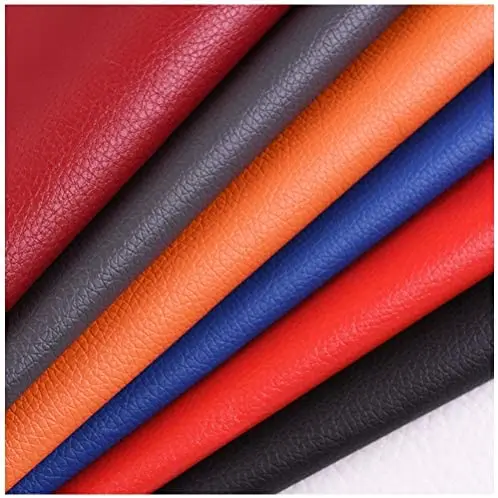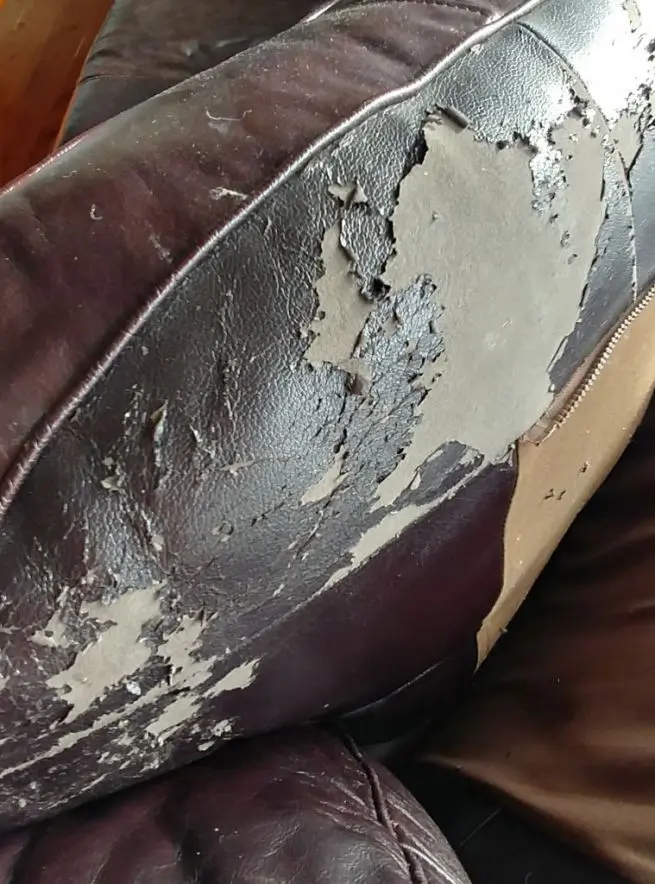Is PU Leather Any Good?
I am thinking of buying a PU leather sectional.
I spent today visiting Basset, Havertys and Furniture Row to test drive leather sectionals from $2-5K.
Mostly I looked at leather match sectionals.
But one salesperson showed me a simulated leather sectional that he said was a 50/50 PU leather blend.
I was quite impressed by the look and feel of it, but I remember seeing some bad reviews about PU leathers saying that they can peel.
Do you have any opinion about PU leather or 50/50 PU Blends?
The description “PU Leather” can be very confusing.
There are three different definitions that are constantly being confused with one another.
The term “PU leather” started off as shorthand for 100% Polyurethane synthetic (faux) leathers.
Polyurethane synthetic leathers have been around for several decades. They can be very durable, and they can look and feel very similar to real leather from hides.
100% polyurethane faux leathers do not peel.
Polyurethane synthetic leather is usually better at simulating real leather than vinyl, another 100% synthetic leather material.
Prior to 2010, furniture shoppers shunned all synthetic leathers. They wanted the real thing, even though most people couldn’t afford larger pieces made from real leather.
Only a very small percentage of stationary and reclining seating was sold in synthetic leathers.
Vinyl was more popular than polyurethane primarily because the vinyls used for residential seating were cheaper than the polyurethanes.
(There are also very expensive heavy-duty vinyls. These are used primarily on commercial and institutional furniture.)

Bonded leather was introduced in 2010.
Bonded leather created a revolution in the furniture industry, especially for reclining furniture.
For the first time in history, “cheap leather furniture” became widely available.
Recliner chairs, made with real leather, had been popular prior to 2010. With bonded leather, larger pieces, including leather sofas and sectionals, now seemed to be affordable for most people.
Furniture shoppers who had rejected 100% polyurethanes and vinyls, accepted bonded leather because it was marketed as “partially real leather.”
Salespeople quickly discovered bonded leather was an easy sale when they implied that bonded leather, made with some “real leather” in it, was superior to the 100% synthetics.
Bonded leather, made with “real leather” was instantly accepted by shoppers desperate for cheap leather furniture.
What was not told to the customers was that bonded leather was extremely delicate and could start peeling or flaking if exposed to cleaning chemicals, sunlight, heat, or general use.
The result was hundreds of thousands of complaints about “leather“ that peeled off within 1 to 3 years (and sometimes sooner.)

For the decade that started in 2010, bonded leather reclining furniture was the fastest growing category in the furniture industry.
Thousands of shoppers each year thought they were buying real leather at cheap prices.
Eventually, some shoppers started becoming aware there were serious problems with this material called “bonded leather” and actively tried to avoid it.
After thousands of well-publicized complaints, some furniture salespeople and other industry professionals began avoiding use of the “bonded leather” terminology.
Since bonded leather also has polyurethane, many people in the furniture industry, and people who write about furniture, started referring instead to “PU leather.”
The term PU leather is sometimes used to describe bonded leather.
Bonded leather peels!
There have been hundreds of thousands of complaints over the past 15 years.
That’s why you have heard (or read) negative things about PU leather.
4 or 5 years ago, new 100% synthetic composite faux leathers were introduced.
Gradually, these replaced bonded leather in residential furniture.
Office furniture has been slower to eliminate bonded leather.
100% polyurethane and vinyl synthetic leathers had been around for many decades.
100% polyester synthetic leathers have also available. These were less commonly used for furniture because they didn’t look or feel very close to real leather.
A few years ago, new 100% synthetic composite faux leathers were introduced.
Most of these are a combination of polyester and polyurethane.
Polyester is less expensive than polyurethane.
By substituting cheap polyester for some or most of the polyurethane, new composite polyester/polyurethane faux leathers were created that looked very similar to the 100% polyurethanes, but at a lower cost.
Polyurethane is more expensive than polyester. While cheaper blends might have 98% polyester and 2% polyurethane, the more expensive blends (which look and feel more like real leather) might be closer to 50/50.
The more expensive composites (with less polyester and more polyurethane) may or may not be more durable than the cheaper composites with more polyester.
These 100% synthetic composite faux leathers have now been in the marketplace for about 5 years with no problems.
Unlike the situation prior to 2010, furniture shoppers now seem to have no problem with buying 100% synthetic leather materials.
If your salesperson is showing you a 50/50 PU leather, it is a 50% polyurethane and 50% polyester material.
It should look and feel very similar to real leather, and be very durable.
Vegan Leather is another confusing term.
When Vegan leathers were first introduced, the term was used exclusively to describe faux leathers made with natural plant based materials.
Very quickly, the term was borrowed to describe all synthetic faux leathers that have no animal products.
Under the more widely used current definition, bonded leather is not a Vegan leather because it includes some of the scrapped leather hides.
100% synthetic faux leathers made from plastics and oil-based products are now being described as “Vegan leathers” by many people throughout the furniture industry.
